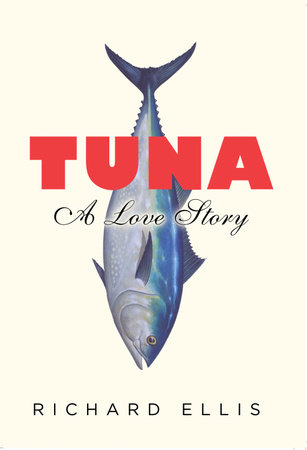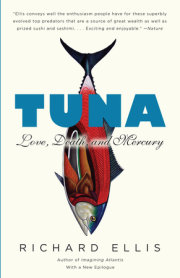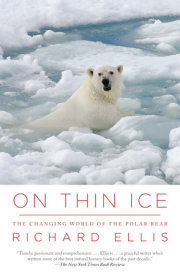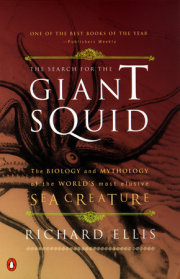Four
SPORT FISHING FOR TUNA
Around 1496, Wynkyn de Worde, one of the first printers in England,printed the
Treatyse of Fysshynge with an Angle, which was basedon even earlier treatises on “fysshynge.” Izaak Walton published
The Compleat Angler in 1653, inspiring a vast number of his fellow Englishmen to take up fishing. But no matter how much they enjoyed the sport, they still ate the fish they caught. Since Walton’s day, however, the art and science of fishing often took precedence over the number and size of the catch that the fisherman brought home to feed his family. Thus did salmon and trout fishing–particularly in England–develop into pastimes suitable for gentlemen, along the lines of fox hunting or bird shooting. The conquest of a fox or a pheasant might require a certain degree of skill and courage, but for the most part, what were needed were a few dogs, a proper kit, and privacy and space enough to engage in these patrician pursuits.
Another field usually restricted to the aristocracy or to those officers posted to exotic locales was big-game hunting. Much of this sort of thing was dedicated to the acquisition of a large set of horns or antlers to display over the mantelpiece, but hunters with powerful weapons also took aim at tigers and leopards in India; lions, leopards, rhinos, and buffalos in Africa; and almost everything larger than a woodchuck in North America: bison, bighorn sheep, moose, elk, every kind of deer, and of course the predators, such as bears, wolves, and mountain lions. If there was ever any justification offered for the slaughter of these animals, it was a sort of hunters’ “manifest destiny”: the privileged classes were entitled to shoot everything with legs or wings, and if the targets happened to be predators, so much the better, the hunters were making the world safer for farmers and their livestock. If and when the predators preyed upon people–think of “man-eating” lions and tigers–well, it was clearly the duty of the hunters to rid the world of these malicious carnivores.
No fish ever threatened a farmer’s livestock, and with the possible exception of some of the larger shark species, none threatened people either. But because some fish were so large and so powerful that their capture required more than a little skill (and often a lot of expensive equipment, sometimes including a big boat), the idea of big-game fishing was born. In his discussion of the origins of the very exclusive Cat Cay fishing resort in the Bahamas, Philip Wylie explained, “the day came when men who had once exulted over a three-pound trout taken on a rod and reel began to think three hundred pounds was no great shakes for hefty relatives of the same species of tackle. This new sport was dashing, daring–and expensive. And for those who could afford it, there was a need of a base suitable to the tastes of the elite.” The idea of catching fish that you had no intention of eating–fishing for sport, in other words–is a very recent development, and probably to some extent based on the great billfishes. They certainly are edible, but fight takes precedence over fillets, and the idea of eating a thousand pounds of fish might be a little daunting to any but the most intrepid (or hungry) angler.
Obviously, “big-game fishes” had to be big–many of them could exceed a thousand pounds–but they also had to be “game,” that is, prepared to put up a valiant fight to escape capture. This conspicuous reluctance to be reeled in often took the form of spectacular, repeated leaps out of the water, an exaggerated, large-scale version of the fight a hooked salmon might put up. The pursuit of large fishes on an adversarial basis began in the early decades of the twentieth century, where the goal was the conquest of an opponent worthy of an intrepid and well-outfitted fisherman. (The idea of fishing for food was eschewed; some of these big-game fishes were far too large to be eaten by anything but a small village.) The big-game fishes include the larger tunas–bluefin and yellowfin–and all the billfishes: the marlins, sailfish, spearfish, and of course the broadbill swordfish.
In Van Campen Heilner’s 1953 history of saltwater fishing, welearn:
The first sportsman to test the quality of Nova Scotia tuna... was Thomas Pattilo, a schoolmaster, who tackled them from a dory in Liverpool harbor in 1871. He took thirty-two fathoms of ordinary codline, wound it on a swivel reel of some sort, fashioned a hook of steel “three-eighths inches thick, eight inches long, with a three inch shank,” and sallied forth in an ordinary fisherman’s dory with a single companion. He was soon hooked to a monster tuna which towed his boat across the harbor and hurtled it merrily into a fleet of herring netters, swamping one and creating havoc with the rest. One of the irate herring fishermen cut the line and thus Pattilo’s first tuna got away.
On Pattilo’s second attempt–presumably with the same gear-he brought to gaff a six-hundred-pound bluefin. In 1908, Commander J. K. L. Ross came to Cape Breton Island in pursuit of these monster mackerel, and although he managed to hook twenty-two of them during the season, he lost every one. The following year, he hooked one that towed him all over the harbor for nineteen hours before “the exhausted sportsman admitted defeat and cut his line.”
Sailors and fishermen who found themselves off the coast of Seabright, New Jersey, in the early decades of the twentieth century were aware that there were some large fish there. They just couldn’t figure out how to catch them. Heilner, who fished there between 1912 and 1916 (with Zane Grey, among others), wrote:
We fished off Seabright out of bank skiffs, sitting on camp chairs, and we gave those giant horse-mackerel some of the finest collection of hooks and lines you ever saw.We could hook them, and that was about all. The rest was fun for the horse-mackerel . . . They looked as big as hogsheads there under the sterns of our dories and some of them ran over a thousand pounds. I saw a fish there one day so big it scared me. I was afraid to put a bait over for fear he’d take it.
On September 13, 1915, wearing a primitive harness, Jake Werthheim hauled in the first New York Bight “horse mackerel,” a monster of 286 pounds. Seven years later, Christian Feigenspan landed a 407-pounder, and that American record stood until Francis Low boated a 705-pounder in 1933. The big fish then seemed to disappear from New Jersey waters. According to Al Anderson’s history of the tuna fishery, fishing for giants off New Jersey did not resume until the 1980s. Captain Al Ristori caught a 1,022-pound fish in 1980 that held the New Jersey record for a little more than a year, when Roy Parsons landed one that weighed eight and one-half pounds more. The current American record holder is Jim Dempsey, who reeled in a fish of 1,140 pounds off Galilee, Rhode Island, in 1981.
Zane Grey, considered the most macho of big-game fishermen–at least until Hemingway came along–had been christened Pearl Gray, after the color Queen Victoria had made popular in 1872, the year of his birth. He grew up hating his given name, changed the spelling of “Gray” to “Grey,” and renamed himself “Zane” after his mother’s family, the Zanes of Virginia, who had founded Zanesville, Ohio. The author of popular western novels in the 1920s and 1930s, Grey was a passionate big-game fisherman, spending most of his not inconsiderable royalties (his books sold 13 million copies) on fishing trips, boats, and gear. In addition to books like
Riders of the Purple Sage, he also wrote about his fishing experiences, and in
Tales of Swordfish and Tuna (1927) he described his battles with giant bluefin tuna, first in California waters and later off Nova Scotia. Grey admired the tuna so much that his writing approximated the fury and excitement of a tuna feeding frenzy. Here is an example, written in 1925:
The giant Nova Scotia tuna, if he struck a trolling bait, would demolish the tackle and jerk the angler overboard. I have no idea what a splash he would make, but it would be tremendous. Bluefin tuna, at Catalina, hitting a bait attached to a kite, make a thrilling strike. A bulge appears behind the skipping bait, then the tuna dives. Smash! He makes a round cracking circle of foamy water. The blue-fin hitting a trolled bait–as was the method before kite-flying–makes the same kind of a strike, only magnified in every way, and of course the angler gets the full benefit of that powerful smash.
With Captain L. D. Mitchell, an Englishman who worked in the fishing tackle department of Abercrombie and Fitch in New York, Grey headed for Nova Scotia in 1924. Near Liverpool, with Mitchell accompanying him in a twenty-foot skiff, he hooked a bluefin and fought it for five hours: “The tuna heaved to the surface, he rolled and gasped, lunged out his huge head with jaws wide and black eyes staring– a paralyzing sight for me. Then he wagged toward to the bow, his wide back round and large as a barrel, out of the water.” Mitchell called it the “gamest tuna I ever saw or heard of.” Brought to the dock, it measured 8 feet 4 inches in length, 6 feet 2 inches in girth, and weighed 684 pounds. In the prose for which he was famous, Grey described the vanquished fish:
He was built like a colossal steel projectile, with a deep dark blue color on the back, shading to an exquisite abalone opal hue toward the under side, which was silver white. He blazed like the shield of Achilles. From the edge of his gill cover to the tip of his nose was two feet. He had eyes as large as saucers. His gaping mouth was huge enough to take in a bucket. His teeth were like a strip of sand paper, very fine and small. The massive roundness of his head, the hugeness of his body, fascinated me and made me marvel at the speed he had been capable of. What incalculable power in that wide tail! I had to back away to several rods’ distance before I could appreciate the full immensity of him.
Later, Grey hooked another Nova Scotia monster, and described the chase in prose that could have come straight out of
Riders of the Purple Sage: “Blue Island seemed a mountain, green on top, black at the sea line, a bleak jagged precipitous shore against which the great swells burst ponderously. The white spray shot high. I saw the green swells rise out of the calm sea and move in majestic regularity to crash and boom into white seething ruin . . . The feeling of the sea under me was something at the moment to take heed of. If I had not been hooked to what must be a gigantic tuna, I would have grown panic-stricken.” This time his brother R.C. and his son Romer were along, and Romer cried out, “Must be a whopper! Don’t work too hard, dad. Don’t let him get away. Don’t give him any rest.” The “whopper” weighed 758 pounds, and Grey rightfully claimed the world’s record for bluefin tuna. As he described it:
I was struck dumb by the bulk and beauty of that tuna. My eyes were glued to his noble proportions and his transforming colors. He was dying and the hues of a tuna change most and are most beautiful at that time. He was shield-shaped, very full and round, and high and long. His back glowed a deep dark purple; his side gleamed like mother-of-pearl in a lustrous light; his belly shone a silver white. The little yellow rudders on his tail moved from side to side, pathetic and reproachful reminders to me of the life and spirit that was passing. If it were possible for a man to fall in love with a fish, that was what happened to me. I hung over him, spellbound and incredulous.
Grey was not only among the first to write about tuna fishing, he was among the first to capture these great-hearted fish. Another trailblazer was Michael Lerner (1891-1978), a successful businessman who turned an early and avid interest in hunting and fishing into a mature scientific avocation. Michael was one of seven children of Charles and Sophie Lerner. With his father and brothers he founded Lerner Stores, a nationwide chain of women’s clothing shops, but he left the business that provided enough money for him to pursue his passion for catching very large fish. Michael and Helen Lerner visited the island of Bimini in the 1930s, and by 1936 they had founded the Bahamas Marlin and Tuna Club, with Ernest Hemingway as the first president. Around this time, Lerner’s association with the American Museum of Natural History began, as he would donate his prize catches, often mounted in lifelike poses, to become museum exhibits. As a trustee, he led seven American Museum expeditions (always where there was good fishing) to locations such as Cape Breton Island (Nova Scotia), Bimini, Australia, New Zealand, Peru, Chile, and Ecuador.
Lerner was also among the first anglers to seek out the giant tuna of Nova Scotia, pioneering the rod-and-reel fishery for giant tuna there in 1935. In eleven days in September 1935, he caught eleven that ranged from 86 to 450 pounds. He was also the principal organizer of the International Game Fish Association (IGFA), which held its first meeting at the American Museum of Natural History on June 7, 1939. Also in attendance were Van Campen Heilner and museum ichthyologists Francesca La Monte, John Nichols, and William Gregory. Lerner agreed to “personally underwrite all the expenses of the new organization, a level of support he would continue to maintain until his resignation as IGFA President in 1961” (Rivkin 2005). Almost alone among the company of big-game fishermen, Lerner never wrote a book about his accomplishments–which were significant in both ichthyology and angling. It would be up to others, such as Mike Rivkin, who wrote a history of the IGFA in 2005, to record Lerner’s fascination with the giant tuna.
Fishing off Long Island (New York) in the 1920s, Lerner caught a seventy-pound bluefin, and was so impressed with its brawn that he was prepared to devote a good part of his life to the pursuit of big, powerful fishes–including
Thunnus thynnus. In the early thirties, Heilner had set up a primitive fishing camp on the island of Bimini, less than a hundred miles east of Miami, and invited Mike and Helen Lerner to join him. (The Lerners would eventually build a house there, which was subsequently turned into the Lerner Marine Laboratory.) In 1935, Lerner’s tuna fishing off Wedgeport, Nova Scotia, was successful beyond all expectations; in eight days he caught twenty-three fish that weighed a total of 5,536 pounds. Francesca La Monte was one of the ichthyologists on his expedition, and in her children’s book
Giant Fishes of the Open Sea, she described Lerner’s fishing style at Louisburg:
He was accustomed to using the best equipment, including a well-outfitted cabin cruiser, but here at Louisburg, things were different. He had to do his fishing from a small dory. It was an awkward and dangerous arrangement. His swivel fishing-chair had to be crudely attached to the bottom planking of the boat. This clumsy, low-lying craft pitched and rolled in the rough water, but Mr. Lerner expertly handled his rod and reel and made some very fine
catches.
Copyright © 2008 by Richard Ellis. All rights reserved. No part of this excerpt may be reproduced or reprinted without permission in writing from the publisher.







